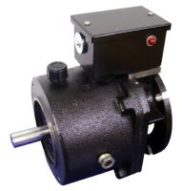Coupler Brake Reduces Inventory and Maintenance Costs

Force Control Industries, Inc. recently developed a double C-face coupler brake that mounts on the drive end of a standard C-Face motor, replacing the commonly used motor brakes mounted on the back of a special motor designed with a mounting flange and extended shaft on the fan end of the motor. Mounting the Force Control double C-Face brake between the reducer and C-Face motor allows a standard C-face motor to be used. Since many plants stock C-face motors for other applications, this eliminates the purchasing and stocking both of a brake motor, and a standard C-face motor, simplifying inventory and reducing costs. Applications include palletizers, packaging machinery, airline baggage handling systems, concrete block manufacturing, cranes and more.
In addition to providing a savings on inventory costs for motors, the use of Force Control Oil Shear brakes also reduces maintenance costs.The Posistop air actuated and the new MagnaShear electrically actuated coupler brakes, never need adjustment, and last 5 to 10 times longer without maintenance. A simple annual fluid change, without removing the motor, is all that is required to keep these proven brakes operating smoothly. Traditional dry brakes, on the other hand, require frequent maintenance and adjustment, replacement of disc, coils and failed linkages which necessitates the removal of the motor every time maintenance is performed – a time consuming and expensive process.
In many standard industry applications where a brake is required, and cycle rates are low enough to allow starting and stopping of the motor, a brake motor is used. This is typically an electric motor which has a NEMA or IEC mounting face and extended shaft to accept a motor brake. This design requires a non-standard motor incurring higher cost, and long deliveries. In many cases the brake is integrated into the motor so deeply that the only solution is replacing the brake and or motor with the same brand.
Force Control double C-face coupler brakes, however, mount between the reducer input and the motor, allowing the use of a standard C-face motor. This eliminates the need for a special motor with a longer lead time and higher price. Many industrial facilities stock C-face motors for other equipment, thereby simplifying stocking while reducing inventory costs.
What is Oil Shear Technology?
Unlike dry brakes, oil shear technology includes a layer of automatic transmission fluid between the brake disc and the drive plate. As the fluid is compressed, the fluid molecules shear – thus imparting torque to the other side. This torque transmission causes the stationary surface to turn, bringing it up to the same relative speed as the moving surface. Since most of the work is done by the fluid particles in shear, wear is virtually eliminated. Elimination of wear also eliminates the need for adjustments which are common for dry braking systems.
In addition to transmitting torque, a patented fluid recirculation system helps to dissipate heat which is the major problem with traditional dry brakes. Along with heat removal and torque transmission, the fluid serves to continually lubricate all components of the oil shear brake, elongating their service life. Posistop and MagnaShear brakes with oil shear technology provide significantly longer service life, characterized by virtually maintenance-free operations.
Product NewsIn addition to providing a savings on inventory costs for motors, the use of Force Control Oil Shear brakes also reduces maintenance costs.The Posistop air actuated and the new MagnaShear electrically actuated coupler brakes, never need adjustment, and last 5 to 10 times longer without maintenance. A simple annual fluid change, without removing the motor, is all that is required to keep these proven brakes operating smoothly. Traditional dry brakes, on the other hand, require frequent maintenance and adjustment, replacement of disc, coils and failed linkages which necessitates the removal of the motor every time maintenance is performed – a time consuming and expensive process.
In many standard industry applications where a brake is required, and cycle rates are low enough to allow starting and stopping of the motor, a brake motor is used. This is typically an electric motor which has a NEMA or IEC mounting face and extended shaft to accept a motor brake. This design requires a non-standard motor incurring higher cost, and long deliveries. In many cases the brake is integrated into the motor so deeply that the only solution is replacing the brake and or motor with the same brand.
Force Control double C-face coupler brakes, however, mount between the reducer input and the motor, allowing the use of a standard C-face motor. This eliminates the need for a special motor with a longer lead time and higher price. Many industrial facilities stock C-face motors for other equipment, thereby simplifying stocking while reducing inventory costs.
What is Oil Shear Technology?
Unlike dry brakes, oil shear technology includes a layer of automatic transmission fluid between the brake disc and the drive plate. As the fluid is compressed, the fluid molecules shear – thus imparting torque to the other side. This torque transmission causes the stationary surface to turn, bringing it up to the same relative speed as the moving surface. Since most of the work is done by the fluid particles in shear, wear is virtually eliminated. Elimination of wear also eliminates the need for adjustments which are common for dry braking systems.
In addition to transmitting torque, a patented fluid recirculation system helps to dissipate heat which is the major problem with traditional dry brakes. Along with heat removal and torque transmission, the fluid serves to continually lubricate all components of the oil shear brake, elongating their service life. Posistop and MagnaShear brakes with oil shear technology provide significantly longer service life, characterized by virtually maintenance-free operations.





